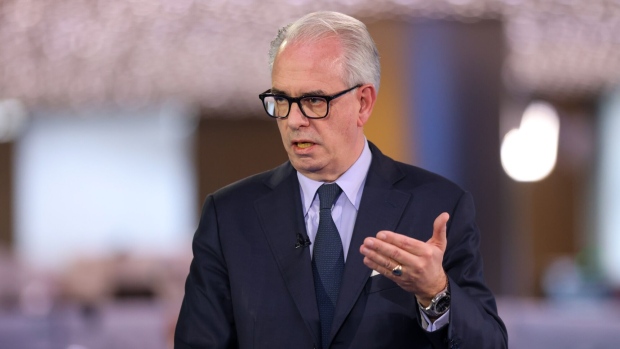Mar 14, 2023
Credit Suisse CEO Urges Patience as Bank Sees Inflows This Week
, Bloomberg News

(Bloomberg) -- Credit Suisse Group AG Chief Executive Officer Ulrich Koerner pleaded for patience to orchestrate his radical overhaul, buoyed by signs that client confidence could be returning and faster progress on job cuts.
Business momentum improved this quarter, including in the markets unit, Koerner said in a Bloomberg Television interview on Tuesday, adding that the bank attracted funds after the collapse of Silicon Valley Bank. Koerner is seeking time to pull off his turnaround plan and signaled he’s not focused on the stock, which is hovering near a record low.
“Nobody is pleased by the share price development, but we manage what we can manage, and this is the execution of our plan,” Koerner said, adding that the bank is ahead on several metrics including workforce reductions and the sale of its securitized products unit. “We said it’s a three year transformation, and you can’t come after two months, ‘Why is everything not done?’”
Credit Suisse dropped as much as 15% in two days, the most of any major European bank, as the collapse of Silicon Valley Bank threw markets into disarray. The lender said in its annual report earlier Tuesday that client outflows continued into March, and it flagged weaknesses in its procedures for financial reporting.
“We got inflows yesterday, which is a positive sign I would say,” Koerner told Francine Lacqua. “We even saw material good inflows yesterday.”
The shares pared declines after his comments and were up 1.1% at 1:55 p.m. in Zurich, after earlier declining as much as 6.1%
Koerner is attempting to push through a complex restructuring in a bid to return the bank to profitability, a process now at risk of becoming bogged down in a broader financial-sector selloff and concerns about many banks’ financial health. The stock has fallen about 20% this year and the market cap lift from a 4 billion franc capital raise completed in December has almost gone.
“We are absolutely doing the right thing, it takes some time to get through,” he said in the interview. He earlier pointed to the bank attaining job cuts equivalent to 8% of its workforce as a sign of it being ahead of plan and that he’s “super confident” on the bank’s targets, including keeping a 13% CET1 ratio during the restructuring plans.
Switzerland’s second-largest lender, which traces its roots back to 1856, has been pummeled over the last several years by a series of blowups, scandals, leadership changes and legal issues. The company’s 7.3 billion franc loss last year wiped out the previous decade’s worth of profits.
Outflows of client money, at unprecedented levels in early October, haven’t reversed as of this month, though have stabilized at much lower levels after it started a huge campaign to win back client deposits, according to the annual report. The bank confirmed it had also dipped into liquidity buffers as a result of the withdrawals. It’s offering deposit rates that are significantly higher than rivals to win back funds, Bloomberg reported earlier this month.
“We want to get back all what we lost,” Koerner said at an investor conference hosted by Morgan Stanley earlier on Tuesday. “And once we are there, we go beyond and grow the business again.” He reiterated the bank wouldn’t ‘buy’ investor funds by offering rates that were too high.
Huge Outflows
Outflows were at unprecedented levels in early October, after a social media firestorm that questioned the bank’s financial health. All told, the bank lost about 110.5 billion francs of assets in the final quarter of last year.
Other challenges for the bank abound. Ratings downgrades have increased funding costs - something which Koerner said would only come down in the medium term. And the bank is also seeking to spin out its First Boston unit during a harsh climate for dealmaking. Top bankers also continue to leave, worried about pay and the lender’s prospects.
Adding to the complications, the bank was also forced to delay the release of its annual report from last week after the Securities and Exchange Commission raised last-minute queries on cash-flow statements from 2019 and 2020, discussions which the bank said have now been concluded.
Tha bank said that it found “material weaknesses” in its reporting and control procedures for the past two years after the regulators’ queries and is taking remediation steps. Koerner said the lender is “forefully” addressing the issues.
©2023 Bloomberg L.P.


